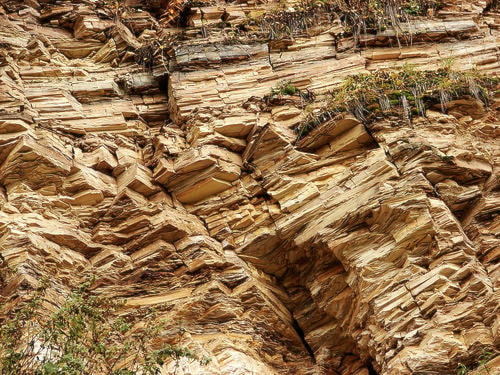Imagine one giant continent made up of all the landmass of the Earth today surrounded by one massive ocean.
That was the configuration of the planet approximately 200 million years ago.
Off the northwest coast of this supercontinent, approximately at the latitude of Mexico City today, the land is shedding mud and sand into the sea creating layers of sedimentary rocks amidst limestone formed by organic materials from sea creatures.
As underlying tectonic plates continuously shift, the supercontinent begins to break apart around 175 million years ago creating the Atlantic Ocean and pushing what is now North America north and west until it collides with a volcanic island chain approximately 130 million years ago.
The collision pushes layers of sedimentary and volcanic rocks up out of the sea, folding them and twisting them into mountains. Pressure and fracturing allows molten magma to rise up from deep in the Earth displacing sedimentatry bedrock and injecting metal-rich fluids into the cracks as the magma solidifies into huge granitic blocks.
Another 60 million years pass and the land starts to pull apart creating fault blocks raising mountains and sinking valleys for around 30 million years allowing more intrusion of granitic magmas, volcanism and mineralization.
Two million years ago, the latest ice age begins. Massive glaciers scour out the valleys as they advance and deposit thick layers of mixed stones, clay, and silt (glacial till) as they recede. For the past 11,000 years rivers further sculpt the landscape.
This story is expressed, of course, in everything we see around us today.
For those, such as geologists, prospectors or students, who want or need a much more technical understanding of the complexity of the geological history of the area, Don MacIntyre and the Smithers Exploration Group have created an extensive self-guided tour from of the major rock formations from Topley to the Hazeltons.
It includes more than 30 stops and takes approximately two days to complete and is accompanied by extensive technical notes on each of the sites. From approximately 300 million-year-old limestones to 50 million-year-old volcanic flows and similarly-aged fossil-bearing sedimentary strata, the entire geologic history of the Bulkley Valley is on display from easily accessed spots along the highways.
Although the tour is designed for professionals, it does identify the locations of some very interesting rock formations that could be enjoyed by anybody interested in the natural beauty of the valley.
Also, MacIntyre and the SEG are working on a simplified version of the tour for non-professionals and plans are in the works for a stationary tour of rock samples from the sites that will be displayed at the SEG offices in Smithers.
